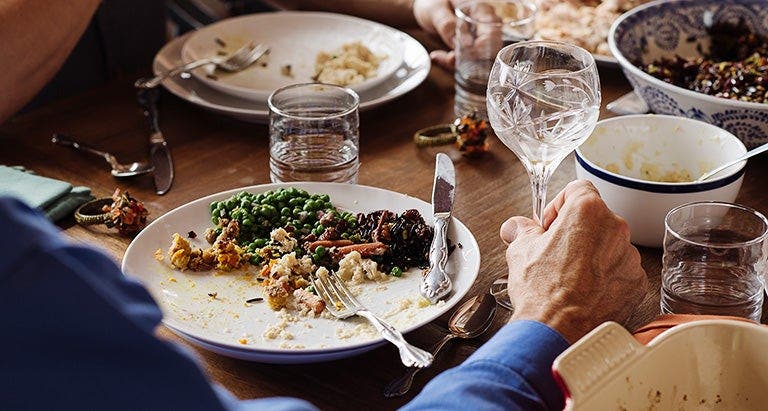Am I Really Hungry?


If you’re trying to lose weight, you’ve probably heard overly-simple advice like, “Just eat when you’re hungry.” But for the vast majority, true hunger isn’t that easy to separate from wanting to eat for excitement, energy, or comfort.
“Part of your appetite comes from physical hunger, in which your body actually wants energy,” says Stephan Guyenet, PhD, author of The Hungry Brain. We call this internal hunger, because the cue to eat is coming from your body’s need for more fuel.
“But some [aspects of appetite] can come from thinking that a brownie looks really amazing,” Guyenet says. We call this external hunger — when the urge to eat is coming from a stimulus that’s not your own body, like eating because it’s routine, “it’s time,” everyone else is, or because there's tempting food nearby.
Knowing the difference between these internal and external hunger cues is important. Of course, one of the joys in life is eating something like a warm cookie (whether you’re hungry or not), but eating for reasons that aren’t due to physical hunger could result in eating more calories than your body needs.
And telling the difference between internal and external hunger is easier than you might think. Here’s what you need to know to decipher the confusing signals about hunger your body can sometimes send, so you can make the best choice for the moment.
Why do you eat when you’re not hungry?
In short: because it feels good, or it’s a habit we’ve made.
Since tasty foods deliver a mood boost, eating them can also temporarily ease feelings of sadness or stress, says Susan Albers, PsyD, author of Eat. Q.: Unlock the Weight-Loss Power of Emotional Intelligence.
Food can also be a fun little distraction when you’re bored. And sharing food with friends or family, whether you’re hungry or not, can be a source of connection, like everyone going out for pizza after work.
Sometimes being tempted with something you know tastes good also makes you override the fact that you’re not hungry, causing you to eat anyway. “Convenience is very, very powerful,” Guyenet says. “You don’t really have to be hungry to grab a handful of chips as you’re walking past them.”
And then, of course, there’s the power of habit, which can drive you to eat regardless of physical hunger. If you tend to eat popcorn while watching a movie, you might grab a bag for snacking without even thinking about it.
How to recognize real hunger
With all of those non-hunger motivations causing you to want to eat, it can feel tricky to tell when your body actually needs food.
First, tune into your body. Actual internal hunger is accompanied by physical sensations that are hard to miss: Your stomach might feel empty or start to rumble, your energy might be a little low, and you may feel shakiness, a headache, and have a hard time focusing. And the longer it’s been since your last meal, the stronger these signals will start to get, Albers says.
Notice what foods pique your interest, too. When you’re hungry, even simple, healthy foods like an apple or unsalted, raw almonds will sound appealing. But if you’re only in the mood for something specific — like barbecue potato chips or a peanut butter brownie — your desire to eat is probably coming from somewhere else, Albers explains.
Ways to curb eating when you’re not internally hungry
Eating when you’re not feeling internal hunger is fine to do occasionally, but can lead to weight gain if you do it often.
To tell whether you’re feeling internal or external hunger, try to tune into your emotional state. For many, feeling flustered or overwhelmed can trigger the desire to eat, regardless of hunger, Albers says. Everyone is going to feel these emotions sometimes and that's normal — so it's worth it to find ways to cope that aren't related to eating. Taking steps like exercising, meditation, or journaling to keep your stress levels in check can also help. And make sure you’re not procrastinating on getting into bed: Studies show that getting enough sleep can act as a buffer against stress eating.
Next, reduce the chances you’ll eat when you’re not hungry by making your favorite foods a little harder to access. This will give you time to consider if you really want to eat them. Ideally, don’t bring those impossible-to-resist foods home — requiring a trip to the grocery store or ice cream shop make procuring a scoop a lot harder than if your freezer is already stocked with treats. If you do end up buying a treat, tuck it away in the back of the freezer (or pantry) instead of keeping it visible, where it’s easy to grab without thinking. “Modify your environment so it doesn’t present easy, tempting food cues,” Guyenet says.
It can really help if you take a moment before you eat to ask yourself some questions:
- How long has it been since I had food? The longer you’ve gone without eating, the more likely it is you’re feeling internal hunger, which most people feel roughly 3-4 hours after the last time they’ve eaten.
- Am I feeling physical sensations, such as tummy rumbling and low energy? If so, you’re likely hungry.
- How am I feeling emotionally? If you’re trying to meet another need like boredom or sadness, you’re likely not hungry.
- What foods sound appealing to me? If almost anything will do, it’s likely internal hunger. If the only thing that sounds appealing is one specific food or type of food, it’s likely external hunger.
The bottom line
There are many reasons people eat that have nothing to do with physical hunger, including emotions, a desire to connect with others, and habit. Eating when you’re not physically hungry can cause you to eat more calories than you otherwise would, making it harder to maintain your weight. Before you eat, ask yourself if you have physical signs of hunger — a rumbling tummy, feeling weak — and, if not, do a quick check to see why you’re really reaching for food.
This content is for informational purposes only and does not constitute medical advice, diagnosis or treatment. It should not be regarded as a substitute for guidance from your healthcare provider.
Eating not for hunger’s connection to obesity: Nutrients (2023). “The Association of Emotional Eating with Overweight/Obesity, Depression, Anxiety/Stress, and Dietary Patterns: A Review of the Current Clinical Evidence.” https://pmc.ncbi.nlm.nih.gov/articles/PMC10005347/
